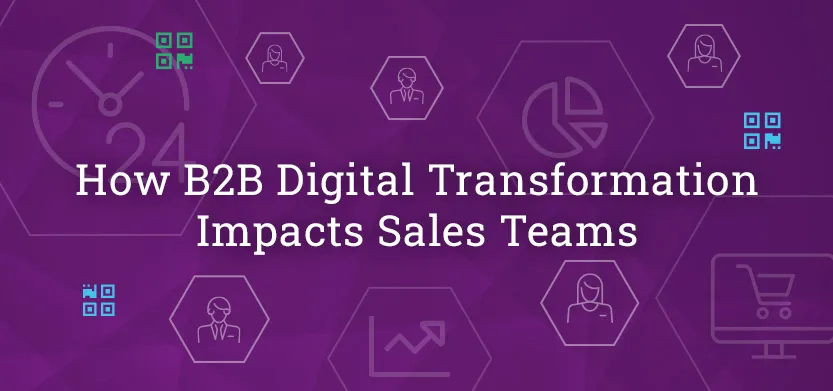
Author
Laura Meshen
, Content Marketing Specialist
Posted in Consulting, Digital Commerce
March 25, 2021
How B2B digital transformation impacts sales teams
As disruptions continue during the pandemic, there are a few ways that a B2B digital transformation can impact your sales team. Let’s look at the shift to digital sales solutions and how businesses can reinvent the way they sell.
How to help sales teams adapt to B2B digital transformation
“Business-to-business companies are, for the large majority, still selling in a traditional way with sales teams on the ground dealing with long sales cycles and negotiations. This way of selling no longer matches the expectations and new behaviours of B2B Buyers who tend to “shop around” favouring smooth digital experiences and limiting their interactions with sales teams. How can businesses adapt to this digital selling shift and reinvent the way they sell?” — What’s impacting the progress and effectiveness of B2B sales transformation? The Drum
So, what does all that mean, really? And how can we get our sales teams to be ready to engage customers in this digital shift?
What it means: a shift to digital and self-service channels is coming. B2B buyers are demanding it, and businesses that don’t give in to those demands will fall behind.
Think about it this way: if your sales team spends less time educating potential customers on your offerings, that time can be used elsewhere. Like closing deals or chasing qualified leads. But that doesn’t start until you build a digital solution that frees up time in the sales process. These digital assets could be an ecommerce site, a product catalogue portal, or even a solution that integrates various operational systems. Each serves a purpose: taking a manual task out of the hands of your sales team.
Use digital assets to make the B2B buyer’s decision-making process easier
Instead of your sales team being the front line for B2B buyers, position your website, blog, product catalogue and other online properties to be the first source of information for prospective buyers. Supply prospective buyers with all the information they need to make an informed decision on your website and social channels. Make the user experience smooth and intuitive. Ensure that your site has the most up-to-date information available and that it is easy to consume..
Pro tip: Clearly defined features and benefits of your offerings will make the content jump off the page.
Use your sales teams to facilitate complex buying decisions
Not all buying decisions are easy and sometimes, buyers will need more information than what your website can provide. This is where your salespeople can step in. Train them to be experts in your product or services, beyond reciting the catalogue or website pages. Have them talk about real use cases and in-depth feature specs. Sales teams need to focus on helping buying groups feel more confident in their decisions.
Pro tip: Your sales team is the embodiment of your business. Positioning them as experts leads to better buyer confidence.
Use your ecommerce site to simplify buying transactions
Simple is best. And there aren’t many things simpler than making the decision to reorder a product from a company you know and trust. Your existing customer base wants to re-order online (whether they know it or not) since they already know and trust your business. By creating an easy-to-use reorder option within your commerce platform your existing customers can easily and simply place orders as they need.
Pro tip: Work with a targeted group of customers in a “beta” launch to highlight the functionality and gather feedback. Choose your most vocal customers, even if they are not the customers who place the most orders or generate the most revenue.
Use your sales team to promote your digital solutions
Encourage your sales teams to promote your digital commerce site. Continue to incentivize your teams with commissions or bonuses, even if the customer’s order is placed online. By moving simpler orders to your online portal, you allow your sales teams to focus on gaining new customers.
Use your training budget to increase digital skillsets in the sales organization
Salespeople with superior digital skills can sell effectively through all your digital channels. Not only that, they are better equipped to adapt to changes in your buying environment. Spending time and money to train your sales teams on how to use your digital assets (websites, portals, social media, chatbots, CRM and any other electronic selling tool you may use) will pay for itself in spades in sales flexibility and manoeuvrability.
Two areas to focus on:
- Virtual customer engagement. This includes tactics for pre-sales call planning and preparation and in-meeting practices for ensuring a productive and engaging dialogue with customers during virtual sales interactions.
- Virtual seller enablement. This includes actions for sales enablement in areas such as sales skills, training delivery and onboarding to support sellers in a virtual sales environment and equip them to effectively sell in a remote setting.
As face-to-face interactions with customers decline, suppliers still need to find ways to influence buying decisions. A good place to start is by understanding the reasons buyers make purchase decisions. Our article on the B2B buying journey is a great resource for this.
Making your sales team a part of your ecommerce strategy early and keeping them involved every step of the way will increase internal adoption of your digital solutions. If your sales team is on board, they will be able to get your customers on board.
If you are worried about how to get your sales team on board with digital transformation, check out our B2B stakeholder interview guide for ideas on how to best get everyone aligned.
Author
Laura Meshen
, Content Marketing Specialist
Posted in Consulting, Digital Commerce
March 25, 2021


